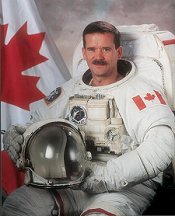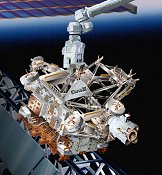The Amazing Canadarm2
| Tweet |  |
The Amazing Canadarm2
Crawling around the International Space Station like
an agile worm, the newest Canadian robotic arm will be essential
for building and maintaining the ISS.

![]() Listen to this story (requires RealPlayer)
Listen to this story (requires RealPlayer)
 April
18, 2001 -- Building a brand new space station is a big job.
Just ask the assembly crews of the International Space Station
(ISS). They have to attach modules weighing tons, extend solar
panels longer than a bus, and haul equipment to and from the
space shuttle. It sounds like these hardworking astronauts could
use a hand!
April
18, 2001 -- Building a brand new space station is a big job.
Just ask the assembly crews of the International Space Station
(ISS). They have to attach modules weighing tons, extend solar
panels longer than a bus, and haul equipment to and from the
space shuttle. It sounds like these hardworking astronauts could
use a hand!
Now, thanks to the Canadian Space Agency (CSA), they're going to get one.
When the space shuttle Endeavour blasts off on mission STS-100, one of its passengers will be a new assistant for the crew of the International Space Station -- an extraordinary robotic arm called Canadarm2.
"Canadarm2 is a bigger, smarter and more grown-up version of the shuttle's robotic arm," said Chris Lorenz, CSA's manager of mission operations. "It's part of Canada's investment in the space station program."
Above: This artist's concept shows the Canadian Space Agency's Mobile Servicing System, which includes Canadarm2, a truck-like base to shuttle the arm from one spot to another, and a 15-jointed dexterous hand. [more information]
 Sign up for EXPRESS SCIENCE NEWS delivery |
Canadarm2 is surely big and strong, but it's not just a brute. This next-generation robotic arm has some amazing tricks up its sleeve. Consider, for example, the way it moves. Unlike the original Canadarm, which is mounted just outside a shuttle's payload bay, Canadarm2 won't be tied down to one spot. Each end of the new arm has a hand that can grasp an anchor on the space station. By flipping end-over-end between anchor points, Canadarm2 can move around the ISS like an inchworm.
With seven joints, Canadarm2 is more maneuverable than its predecessor on the shuttle and even more agile than a human arm. This is important because the space station is a larger and more complex environment than the shuttle's payload bay.
 Astronauts will install Canadarm2 during
a series of spacewalks beginning on Day 4 of the STS-100 mission.
From inside Endeavour, pilot Jeff Ashby will use the shuttle's
robotic arm to lift Canadarm2's pallet from the payload bay.
He'll maneuver it toward the Destiny Lab module where the pallet
will latch on to a special cradle.
Astronauts will install Canadarm2 during
a series of spacewalks beginning on Day 4 of the STS-100 mission.
From inside Endeavour, pilot Jeff Ashby will use the shuttle's
robotic arm to lift Canadarm2's pallet from the payload bay.
He'll maneuver it toward the Destiny Lab module where the pallet
will latch on to a special cradle.
Left: Canadarm2, folded inside its pallet, awaits launch on STS-100.
Next, mission specialists Chris Hadfield (a Canadian) and Scott Parazynski will leave the shuttle's airlock and begin their space walk. The pair will unwrap Canadarm2 from its insulating blankets, attach power to the arm and loosen its restraining bolts. By the end of the day, Canadarm2 will be ready to step out of its pallet.
On Day 6 of the mission, the two space walkers will venture out again. This time they will install a Power Data Grapple Fixture (PDGF) -- that is, a handhold for Canadarm2-- on Destiny itself. When the PDGF is ready, Canadarm2 will reach out from its pallet and grab the space station. It'll be one small step for Canadarm2, and an impressive leap for space robotics!
After a few limbering up exercises, Canadarm2 will hand its pallet back to Canadarm -- a maneuver that scientists have dubbed "the first-ever robotic handshake in space."
 Once
deployed, Canadarm2's primary job will be space station assembly.
Once
deployed, Canadarm2's primary job will be space station assembly.
"On the very next mission, Canadarm2 will be used to install the airlock," said Ken Podwalski, a CSA scientist working with Lorenz. "So we are going from arrival to immediate use on the subsequent mission. This is really the critical piece to continue construction of the space station."
Right: Canadian Space Agency astronaut Chris Hadfield will become the first Canadian to perform a space walk when he helps install Canadarm2 during the STS-100 shuttle mission. [learn more about Chris]
For the next few years, the space station's crew will control Canadarm2 from two identical consoles (called "Robotic Workstations") located inside the Destiny Lab. Eventually one of those workstations will move to The Cupola -- a module tentatively scheduled for launch in 2005. Like the window-studded "Ten Forward" lounge on Star Trek's USS Enterprise, the Cupola --with eight windows-- will provide astronauts a stunning view of the space around the ISS. It's the perfect spot for direct viewing of the robotic arm and shuttle payload operations.
The Canadian Space Agency has also built a ground control center for Canadarm2 at the CSA's Saint-Hubert, Quebec, headquarters. That facility is linked directly to NASA's Mission Control at the Johnson Space Center in Houston, Texas. Crewmembers on board the ISS will be the ones who actually control the arm. Personnel in Quebec and Houston will offer real-time support and troubleshooting while Canadarm2 operations are underway in space.
 Canadarm2
is only the first installment of what the CSA refers to as the
space station's "Mobile Servicing System." The next
piece (slated for launch no earlier than 2002) will be the Mobile
Base System, or MBS -- literally a small truck that moves along
rails covering the exterior of the ISS.
Canadarm2
is only the first installment of what the CSA refers to as the
space station's "Mobile Servicing System." The next
piece (slated for launch no earlier than 2002) will be the Mobile
Base System, or MBS -- literally a small truck that moves along
rails covering the exterior of the ISS.
Left: an artist's rendering of the Mobile Base System, a movable platform that slides along rails on the Space Station's main truss structure.
"After the MBS is in place, we'll be able to move the Canadarm up and down the length of the space station," said Lorenz. Compared to inchworming, riding the MBS will be a less entertaining way to travel -- but much faster.
The final piece of the Mobile Servicing System will be the Special Purpose Dexterous Manipulator, an attachment for one end of Canadarm2. This so-called "Canada Hand" is itself a highly advanced robot with two arms and sophisticated feedback mechanisms that allow it to touch and feel much like a human hand. Equipped with lights, a video camera and four tool holders, the Hand will perform sophisticated operations like installing batteries, power supplies and computers.
 After
it arrives in orbit (no sooner than 2003) the Canada Hand will
be controlled by the ISS crew using one of the Robotic Workstations.
The Hand, which can wield very specialized tools and execute
delicate servicing tasks, could substantially reduce the amount
of time astronauts spend working "outdoors" in the
dangerous environment of space.
After
it arrives in orbit (no sooner than 2003) the Canada Hand will
be controlled by the ISS crew using one of the Robotic Workstations.
The Hand, which can wield very specialized tools and execute
delicate servicing tasks, could substantially reduce the amount
of time astronauts spend working "outdoors" in the
dangerous environment of space.
Right: an artist's rendering of the versatile Special Purpose Dexterous Manipulator attached to the end of Canadarm2.
An inchworming space arm equipped with a robotic super-Hand? It sounds like a wonderful Lego kit! Indeed, Canadarm2 consists of many Lego-like "on-orbit replaceable units" (ORUs). "You can basically take the arm apart in Lego fashion and replace units as needed," added Podwalski.
It would seem to be a case of life imitating toys, but that shouldn't come as a surprise. The designers of Canadarm2 --the same engineers who built Dino the Dinosaur at Universal Studios-- must be kids at heart to develop something so wonderful.
To learn more about Canadarm2 and to follow the progress of its installation on the ISS, visit http://spaceflight.nasa.gov.
Canadian Space Agency -- home page
Canada's Contribution to the Space Station -- learn more about the Mobile Servicing System from the Canadian Space Agency
Canadarm2 -- an overview of the extraordinary arm from the Canadian Space Agency
Profile: Alain Dubeau -- Manager / Canadian Space Station Program
Water on the Space Station -- Science@NASA article: Rationing and recycling will be an essential part of life on the International Space Station. In this article, Science@NASA explores where the crew will get their water and how they will (re)use it.
Breathing Easy on the Space Station -- Science@NASA article: Life support systems on the ISS provide oxygen, absorb carbon dioxide, and manage vaporous emissions from the astronauts themselves. It's all part of breathing easy in our new home in space.
Microscopic Stowaways on the ISS -- Science@NASA article: Wherever humans go microbes will surely follow, and the Space Station is no exception. This article discusses how the ISS will keep microbes to a minimum.
Join our growing list of subscribers - sign up for our express news delivery and you will receive a mail message every time we post a new story!!!
 Headlines
Headlines| The Science and Technology Directorate at NASA's Marshall Space Flight Center sponsors the Science@NASA web sites. The mission of Science@NASA is to help the public understand how exciting NASA research is and to help NASA scientists fulfill their outreach responsibilities. | |
| For lesson plans and educational activities related to breaking science news, please visit Thursday's Classroom |
Authors: Dr.
Tony Phillips, Steve Price Production Editor: Dr. Tony Phillips Curator: Bryan Walls Media Relations: Steve Roy Responsible NASA official: Ron Koczor |